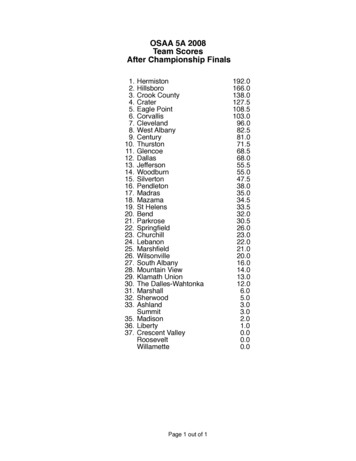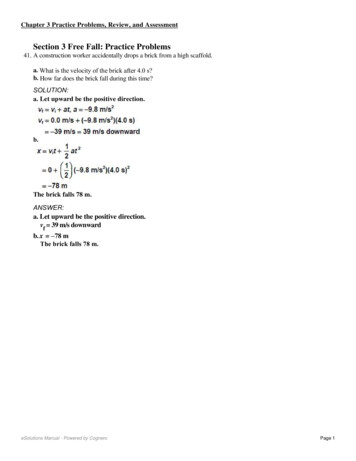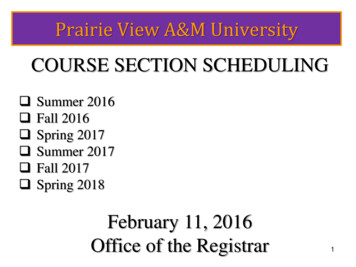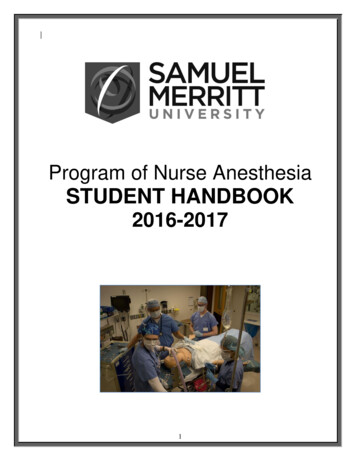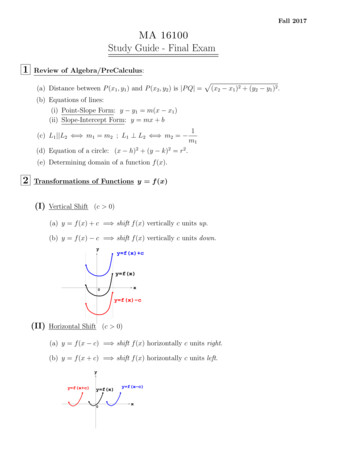
Transcription
Fall 2017MA 16100Study Guide - Final Exam1Review of Algebra/PreCalculus:(a) Distance between P (x1 , y1 ) and P (x2 , y2 ) is P Q p(x2 x1 )2 (y2 y1 )2 .(b) Equations of lines:(i) Point-Slope Form: y y1 m(x x1 )(ii) Slope-Intercept Form: y mx b(c) L1 L2 m1 m2 ; L1 L2 m2 1m1(d) Equation of a circle: (x h)2 (y k)2 r2 .(e) Determining domain of a function f (x).2Transformations of Functions y f (x)(I) Vertical Shift (c 0)(a) y f (x) c shift f (x) vertically c units up.(b) y f (x) c shift f (x) vertically c units down.yy f(x) cy f(x)x0y f(x) c(II) Horizontal Shift (c 0)(a) y f (x c) shift f (x) horizontally c units right.(b) y f (x c) shift f (x) horizontally c units left.yy f(x c)y f(x)0y f(x c)x
(III) Vertical Stretch/Shrink (c 0)y cf (x) stretch f (x) vertically by a factor c. (If c 1, this shrinks the graph.)yy cf(x)y f(x)y 1c f(x)0x(IV) Horizontal Stretch/Shrink (c 0)y f x c stretch f (x) horizontally by a factor c. (If c 1, this shrinks graph.)yy f( xc )x0y f(cx)y f(x)(V) Reflections(a) y f (x) reflect f (x) about x-axis(b) y f ( x) reflect f (x) about y-axisyy f( x)y f(x)0xy f(x)
3Combinations of functions; composite function (f g)(x) f (g(x)); y ex ; exponentialfunctions y ax (a 0 fixed):(a 1)y(0 a 1)yxy ay ax11x04x0Law of Exponents:ax y ax ayaxax y ya(ax )y axy(ab)x ax bx5One-to-one functions; Horizontal Line Test; inverse functions; finding the inverse f 1 (x)of a 1-1 function f (x); graphing inverse functions:yy f 1(x)y xy f(x)x06Logarithmic functions to base a: y loga x (a 0, a 6 1):(0 a 1)y(a 1)yy loga xy loga x071x01xLogarithm formulas:loga x y ay xloga (ax ) x, for every x Raloga x x, for every x 0
8Law of Logarithms:9Finite Limitsloga (xy) loga x loga yxloga loga x loga yyloga (xp ) p loga x(a) lim f (x) Lx ayy f(x)L0xa(b) lim f (x) L (right-hand limit)x ayy f(x)L0xa(c) lim f (x) L (left-hand limit)x ayy f(x)L0Recall:xalim f (x) L lim f (x) lim f (x) Lx ax ax a
10Infinite Limits(a) lim f (x) x ayy f(x)xa0(b) lim f (x) x ayy f(x)xa0(c) lim f (x) x ay f(x)y0xaRemark: The line x a is a Vertical Asymptote of f (x) if at least one of lim f (x) or lim f (x)x aor lim f (x) is or .x a11Limit Laws; computing limits using Limit Laws;Squeeze Theorem : If h1 (x) f (x) h2 (x) and lim h1 (x) lim h2 (x) L,x athen lim f (x) Lx ax ax a
12f continuous at a (i.e. lim f (x) f (a)); f continuous on an interval; f continuous from thex aleft at a (i.e. lim f (x) f (a)) or continuous from the right at a (i.e. lim f (x) f (a));x ax ajump discontinuity, removable discontinuity, infinite discontinuity:yy tediscontinuityLimit Composition Theorem: If f is continuous at b, where lim g(x) b,x a then lim f (g(x)) f lim g(x) f (b).x a13x aLimits at Infinity(a) lim f (x) L(b)x lim f (x) Lx yy f(x)Lx0yy f(x)L0xRemark: The line y L is a Horizontal Asymptote of f (x).14 yf (x2 ) f (x1 ) ; xx2 x1slope of secant line through two points; average velocity. Definition of derivative of y f (x)f (a h) f (a)f (x) f (a)at a: f 0 (a) limor, equivalently, f 0 (a) lim; interpretationx ah 0hx aof derivative:Average rate of change of y f (x) over the interval [x1 , x2 ] : slope of tangent line the graph of y f (x) at a0velocity at time af (a) (instantaneous) rate of change of f at a
f (x h) f (x)dy ; differentiable functions (i.e.,h 0hdx2dyf 0 (x) exists); higher order derivatives : f 00 (x) 2 , . . . .dx15Derivative as a function: f 0 (x) lim16 yf (x2 ) f (x1 ) (this is also xx2 x1f (a h) f (a)the average velocity). Definition of derivative of y f (x) at a: f 0 (a) limh 0hf(x) f(a)0; interpretation of derivative:or, equivalently, f (a) limx ax a slope of tangent line the graph of y f (x) at a0velocity at time af (a) (instantaneous) rate of change of f at a17Derivative as a function: f 0 (x) limAverage rate of change of y f (x) over the interval [x1 , x2 ] :f (x h) f (x); differentiable functions (i.e., f 0 (x)h 0hexists);d2 yd3 y000;yorequivalently; etc.dx2dx3higher order derivatives: y 00 or equivalently18Basic Differentiation Rules: If f and g are differentiable functions, and c is a constant:(a)d(c) 0dx(b)(c) Power Rule:d(u v)du dv dxdx dx(c)d(xn ) nxn 1dxdd(uv)dvdu(d) Product Rule : u vdxdxdx19Special Trig Limits :Hence also limθ 020d(u v)du dv dxdx dxlimθ 0sin θ 1θlimθ 0Quotient Rule :θ 1sin θlimθ 0 u vdxv dvdu udxdxv2cos θ 1 0 .θsin(kθ)(kθ) 1 and lim 1. Note that sin kθ 6 k sin θ.θ 0 sin(kθ)(kθ)CHAIN RULE: If g is differentiable at x and f is differentiable at g(x), then the compositefunction f g is differentiable at x and its derivative is 00(f g) (x) f (g(x)) f 0 (g(x)) g 0 (x)i.e., if y f (u) and u g(x), thendydy du .dxdu dx
21Implicit Differentiation: If an equation defines one variable as a function of the other(independent) variable, then to find the derivative of the function w.r.t. the independentvariable:Step 1 - Differentiate both sides of equation w.r.t. independent variableStep 2 - Solve for the desired derivative22Logarithmic DifferentiationStep 1 : Take natural log of both sides of y h(x); simplify using Law of LogarithmsStep 2 : Differentiate implicitly w.r.t xStep 3 : Solve the resulting equation for23dydxInverse Trig Functions - Note, for example, sin 1 x is same as arcsin x, but sin 1 x 6 (sin x) 1(a) Definitions:y sin 1 x sin y x ( π2 x π2 )y cos 1 x cos y x (0 x π)y tan 1 x tan y x ( π2 x π2 )(b) Basic Derivatives:d(sin 1 x)1 dx1 x2d(tan 1 x)1 dx1 x2d(cos 1 x)1 dx1 x2If u is a differentiable function of x, then by the Chain Rule,24d(sin 1 u)1du , etc.dx1 u2 dxHyperbolic Trig Functions(a) Definitions:cosh x ex e x2sinh x ex e x2tanh x sinh xex e x xcosh xe e x(b) Basic Derivatives:d(cosh x) sinh xdxd(sinh x) cosh xdxd(tanh x) sech2 xdxIf u is a differentiable function of x, then by the Chain Rule,etc.d(cosh u)du (sinh u) ,dxdx(c) Basic Identities:cosh( x) cosh xsinh( x) sinh xcosh2 x sinh2 x 1
25APPLICATIONSModel 1 - Exponential Growth/Decay:dy kydtwhere k relative growth/decayrate(If the rate of change of y is proportional to y, then the above differential equation holds.) If k 0, this is the law of Natural Growth (for example, population growth). If k 0, this is the law of Natural Decay (for example, radioactive decay).All solutions to this differential equation have the form y(t) y(0) ekt .(Usually need two pieces of information to determine both constants y(0) and k, unlessthey are given explicitly.)Half-life time it takes for radioactive substance to lose half its mass.)Model 2 - Newton’s Law of Cooling : If T (t) temperature of an object at time t andTs temperature of its surrounding environment, then the rate of change of T (t) isproportional to the difference between T (t) and Ts :dT k (T (t) Ts )dtThe solution to this particular differential equation is alwaysT (t) Ts Cekt(Usually need two pieces of information to determine both constants C and k, unlessthey are given explicitly.)Model 3 - Related Rates (Method to Solve) :1 Read problem carefully several times to understand what is asked.2 Draw a picture (if possible) and label.3 Write down the given rate; write down the desired rate.4 Find an equation relating the variables.5 Use Chain Rule to differentiate equation w.r.t to time and solve for desired rate.Useful Formulas for Related Rates(i) Pythagorean Theorem:cbac 2 a2 b 2
Aa bB(ii) Similar Triangles:aAbB(iii) Formulas from Geometry:Circle of radius rSphere of radius rrrA πr24V πr33C 2πrS 4πr2 (surface area of sphere)Cylinders and Cones:hr2V πr hhr1V πr2 h3
Additional Differentiation Formulas(u is a differentiable function of x)dud (un ) nun 1dxdxudud (eu )u du d (a ) e au (ln a)dxdxdxdx1 du d (loga u)1 dud (ln u) dxu dxdxu ln a dxd (sin u)du d (cos u)du (cos u) ( sin u)dxdxdxdxdud (csc u) ( csc u cot u)dxdx26d (tan u)du (sec2 u)dxdxdu d (cot u)dud (sec u) (sec u tan u) ( csc2 u)dxdxdxdxRelated Rates Word Problems Method:1 Read problem carefully several times to understand what is asked.2 Draw a picture (if possible) and label.3 Write down the given rate; write down the desired rate.4 Find an equation relating the variables.5 Use Chain Rule to differentiate equation w.r.t to time and solve for desired rate.27The Linear Approximation (or tangent line approximation) to a function f (x) at x a is thefunction L(x) f (a) f 0 (a)(x a); Approximation formula f (x) f (a) f 0 (a)(x a) forx near a; if y f (x), the differential of y is dy f 0 (x)dx.28Definitions of absolute maximum, absolute minimum, local/relative maxmium, and local/relativeminimum; c is a critical number of f if c is in the domain of f and either f 0 (c) 0 or f 0 (c)DNE.29Extreme Value Theorem: If f (x) is continuous on a closed interval [a, b], then f alwayshas an absolute maximum value and an absolute minimum value on [a, b].
30Method to Find Absolute Max/Min of f (x) over Closed Interval [a, b]:(i) Find all admissible critical numbers in (a, b);(ii) Find endpoints of interval;(iii) Make table of values of f (x) at the points found in (i) and (ii).The largest value abs max value of f and the smallest value abs min value of f .31Rolle’s Theorem: If f (x) is continuous on [a, b] and differentiable on (a, b), and f (a) f (b),then f 0 (c) 0 for some c (a, b).32Mean Value Theorem: If f (x) is continuous on [a, b] and differentiable on (a, b), then theref (b) f (a) f 0 (c) :is a number c, where a c b, such thatb ai.e.,f (b) f (a) f 0 (c) (b a)If something about f 0 is known, then something about the sizes of f (a) and f (b) can be found.33Fact: (Useful for integration theory later)(a) If f 0 (x) 0 for all x I, then f (x) C for all x I.(b) If f 0 (x) g 0 (x) for all x I, then f (x) g(x) C for all x I.
34Increasing functions: f 0 (x) 0 f% ; decreasing functions: f 0 (x) 0 f & .35First Derivative Test: Suppose c is a critical number of a continuous function f .(a) If f 0 changes from to at c f has local max at c(b) If f 0 changes from to at c f has local min at c(c) If f 0 does not change sign at c f has neither local max nor local min at c(Displaying this information on a number line is much more efficient, see above figure.)36f concave up: f 00 (x) 0 fS; and f concave down:f 00 (x) 0 fT;inflection point (i.e. point where concavity changes).(Displaying this information on a number line is much more efficient, see above figure.)37Second Derivative Test: Suppose f 00 is continuous near critical number c and f 0 (c) 0.(a) If f 00 (c) 0 f has a local min at c.(b) If f 00 (c) 0 f has a local max at c.Note: If f 00 (c) 0, then 2nd Derivative Test cannot be used, so then use 1st Derivative Test.38Indeterminate Forms:0(a) Indeterminate Form (Types):0 , ,0 · , ,00 , 0 ,1 (b) L’Hopital’s Rule: Let f and g be differentiable and g 0 (x) 6 0 on an open interval Icontaining a (except possibly at a). If lim f (x) 0 and if lim g(x) 0 [Type 00 ];x ax aor if lim f (x) (or ) and if lim g(x) (or ) [Typex ax a ], thenf (x)f 0 (x) lim 0,x a g(x)x a g (x)limprovided the limit on the right side exists or is infinite.Use algebra to convert the different Indetermine Forms in (a) into expressions where theabove formula can be used.Important Remark: L’Hopital’s Rule is also valid for one-sided limits, x a , x a , and also for limits when x or x .
39Curve Sketching Guidelines:(a) Domain of f(b) Intercepts (if any)(c) Symmetry:f ( x) f (x) for even function;f ( x) f (x) for odd function;f (x p) f (x) for periodic function(d) Asymptotes:x a is a Vertical Asymptote: if either lim f (x) or lim f (x) is infinitex ax ay L is a Horizontal Asymptote: if either lim f (x) L or lim f (x) L.x x (e) Intervals: where f is increasing % and decreasing & ; local max and local minST(f) Intervals: where f is concave up and concave down ; inflection points40Optimization (Max/Min) Word Problems Method:1 Read problem carefully several times.2 Draw a picture (if possible) and label it.3 Introduce notation for the quantity, say Q, to be extremized as a function of one or morevariables.4 Use information given in problem to express Q as a function of only one variable, say x.Write the domain of Q.5 Use Max/Min methods to determine the absolute maximum value of Q or the absoluteminimum of Q, whichever was asked for in problem.41Integration Theory:(a) F (x) is an antiderivative of f (x), if F 0 (x) f (x).Z bf (x) dx is a number; gives the net area under a curve y f (x)(b) Definite Integralawhen a x b; also gives net distance traveled by particle with velocity y f (x) fromtime x a to x b; many other applications (take Calculus II).(c) Properties of Definite Integrals.(d) FUNDAMENTAL THEOREM OF CALCULUS:Z xI If f (x) is continuous on [a, b] and g(x) f (t) dt g 0 (x) f (x).a Z x di.e.,f (t) dt f (x) FTC 1dxa
ZII If F (x) is any antiderivative of f (x) x bbZi.e., F (b) F (a).f (x) dx F (x)ax abF 0 (x) dx F (b) F (a) FTC 2aZ(e) Indefinite Integralf (x) dx is a function.ZZ0Recall that f (x) dx F (x) means F (x) f (x), i.e. the indefinite integral f (x) dxis simply the most general antiderivative of f (x).!Z u(x)ddu(x)(f) FTC 1 with Chain Rule:f (t) dt f (u(x))dxdxaZ(g) Subsitution Rule (Indefinite Integrals):ag(x).Basic Table of Indefinite IntegralsZ(1)k dx kx CZ(3)Z(4)xn dx xn 1 Cn 1(n 6 1)1dx ln x Cxex dx ex CZ(5)cos x dx sin x CZ(6)sin x dx cos x Cb0Zg(b)f (u) du , u f (g(x)) g (x) dx (h) Subsitution Rule (Definite Integrals):(2)f (u) du , u g(x).f (g(x)) g (x) dx ZZZ0g(a)
Z(7)sec2 x dx tan x CZ(8)sec x tan x dx sec x CZ(9)Z(10)1dx tan 1 x C21 x 1dx sin 1 x C21 xZ(11)sinh x dx cosh x CZ(12)cosh x dx sinh x CZ(13)ax dx ax Cln a
19 Special Trig Limits : lim !0 sin 1 lim !0 sin 1 lim !0 cos 1 0 . Hence also lim !0 sin(k ) (k ) 1 and lim !0 (k ) sin(k ) 1. Note that sink 6 ksin . 20 CHAIN RULE: If gis di erentiable at xand fis di erentiable at g(x), then the composite function f gis di erentiable at xand its derivative is

